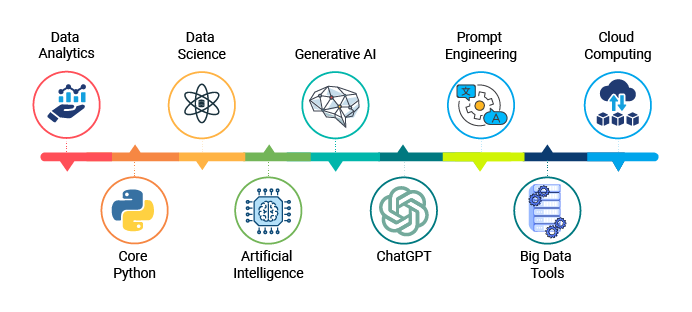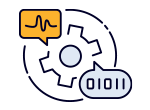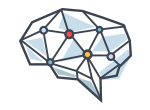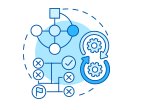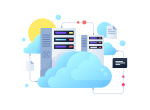Program Highlights
Top-Notch Faculty
Trainers at ExcelR are passionate about training, and carry 12+ years of industry experience.
Exhaustive Course Curriculum
Our industry-relevant course curriculum is tailored to provide practical exposure with the theory.
Real-life Projects
Learners will work on real-life Projects from various domains to get application knowledge.
Job Readiness
Intensive interview preparation from Day 1 to prepare candidates for interviews with our network of 2000+ hiring partners
Skills Covered

Data Analysis concepts

Database concepts

Functions Charts & Slicers
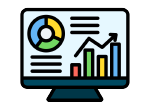
Data Visualization
Tools Covered

Excel

Tableau

Power BI

MySQL
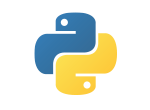
Python

Jupyter Notebook

RStudio

Pandas

NumPy

Matplotlib

Seaborn
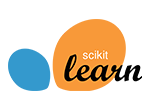
Scikit Learn

Hadoop
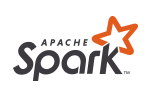
Spark

Pytorch

Keras

TensorFlow

NLTK

OpenCV

Gbard

BERT

Hugging face

ChatGPT

Lang chain

DALL-E 2
Projects
- This Project involves collecting, processing, and visualizing online sales data to derive insights about customer behaviour, sales trends, product performance, and market dynamics, enhancing strategic decision-making. (Beginner)
- This project involves gathering, analysing, and visualizing financial data to uncover insights into customer behaviours, transaction patterns, credit risk, and operational efficiency. This will aid in improving customer service, risk management, and strategic financial planning. (Beginner)
- Your project centres on predicting future gold prices using advanced forecasting techniques. It entails collecting historical gold price data and applying statistical models and machine learning algorithms to identify trends and factors influencing price fluctuations. The goal is to develop accurate predictions that assist investors and financial analysts in making informed decisions. (Intermediate)
- This project is focused on developing a book recommendation system. It involves utilizing user data, book metadata, and reading patterns to create a personalized algorithm. This system will analyse readers' preferences and past interactions to suggest books that match their interests, enhancing user engagement and reading experience. (Intermediate)
- It involves analysing financial data from businesses using machine learning techniques to identify early warning signs of financial distress. By predicting potential bankruptcy risks, the model helps companies implement timely interventions, improving financial stability and decision-making processes. (Advanced)
- A beginner level GAN (Generative Adversarial Network) project, for the fashion industry, involves creating a model that can generate new, realistic clothing designs. In this project, the GAN consists of two parts: a Generator, which produces images of clothing items, and a Discriminator, which evaluates whether these images are real or generated. The training process involves feeding the network with a dataset of various clothing images, allowing the Generator to learn and create novel designs while the Discriminator improves its ability to distinguish between real and synthetic images. (Advanced)
Case Studies
- How a retail company boosted sales using Excel, Power BI, Tableau, and MySQL. Learn how they analysed customer data, tracked inventory, and visualized trends to make data-driven decisions. Discover the impact of these tools on revenue, inventory management, and customer satisfaction, all through this real-world case study.
- Dive into the world of healthcare analytics as we examine a hospital's journey to improve patient care. See how Excel, Power BI, Tableau, and MySQL were used to analyse patient data, track medical outcomes, and enhance resource allocation. Witness the positive transformations in patient care and operational efficiency in this illuminating case study.
- Discover how a retail giant leveraged data science techniques, including regression analysis, to accurately forecast sales and optimize inventory management. Explore the implementation of predictive models using historical sales data and its transformative impact on demand forecasting, reducing waste, and increasing profitability in this compelling case study.
Learning Path
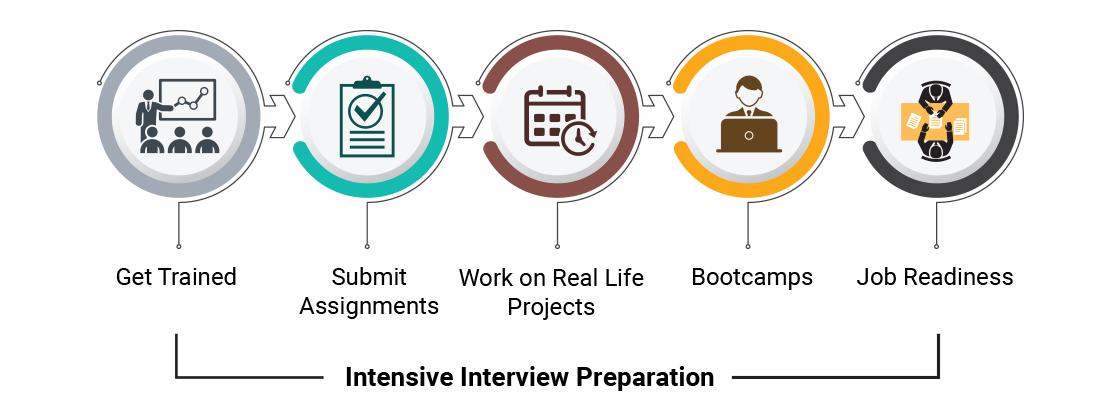
Why ExcelR
Industry-Based Course Curriculum
Hands-on with 100+ Assignments
Job Readiness Program with our 2000+ partner companies
Support through WhatsApp, Calls, & Emails
Lifetime eLearning Access
Course Curriculum
EXCEL
- MS office Versions(similarities and differences)
- Interface(latest available version)
- Row and Columns
- Keyboard shortcuts for easy navigation
- Data Entry(Fill series),Find and Select
- Clear Options,Ctrl+Enter
- Formatting options(Font,Alignment,Clipboard(copy, paste special))
- Mathematical calculations with Cell referencing(Absolute,Relative,Mixed) Functions with Name Range
- Arithmetic functions(SUM,SUMIF,SUMIFS,COUNT,COUNTA,COUNTIFS,AVERAGE,AVERAGEIFS,MAX,MAXIFS,MIN,MINIFS)
- Logical functions:IF,AND,OR,NESTED IFS,NOT,IFERROR Usage of Mathematical and Logical functions nested together
- LOOKUP
- VLOOKUP
- NESTED VLOOKUP
- HLOOKUP
- INDEX
- INDEX WITH MATCH FUNCTION
- INDIRECT
- OFFSET
- Combination of Arithmatic
- Logical
- Lookup functions
- Data Validation(with Dependent drop down)
- Date Functions:DATE,DAY,MONTH,YEAR,YEARFRAC,DATEDIFF,EOMONTH;
- Text Functions:TEXT,UPPER,LOWER,PROPER,LEFT,RIGHT,SEARCH,FIND,MID,TTC, Flash Fill
- Number Formatting(with shortcuts)
- CTRL+T(Converting into an Excel Table)
- Formatting Table
- Remove
- Duplicate
- SORT
- Advanced Sort
- FILTER
- Advanced Filter
- Conditional formatting(icon sets/Highlighted colour sets/Data bars/custom formatting)
- Charts:Bar,Column,Lines,Scatter,Combo,Gantt,Waterfall,pie
- Pivot Reports
- Insert,Interface,Crosstable Reports;Filter,Pivot Charts
- Slicers
- Add,Connect to multiple reports and charts Calculated field, Calculated item
- Dashboard
- Types,Getting reports and charts together, Use of Slicers
- Design and placement
- Formatting of Tables,Charts,Sheets,Proper use of Colours and Shapes
- Power Query:
- Interface, Tabs; Connecting to data from other excel files, text files, other sources, Data Cleaning, Transforming, Loading Data into Excel Query
- Using Loaded queries
- Merge and Append
- Insert Power Pivot
- Similarities and Differences in Pivot and Power Pivot reporting
- Getting data from databases
- workbooks
- webpages
- View Tab
- Add Developer Tab
- Record Macro:Name
- Storage Record Macro to Format table(Absolute Ref)
- Format table of any size(Relative ref)
- Play macro by button,shape,as command(in new tab)
- Editing Macros
- VBA:Introduction to the basics of working with VBA for Excel: Subs, Ranges, Sheets. Comparing values and conditions, if statements and select cases. Repeat processes with For loops and Do While or Do Until Loops
- Communicate with the end-user with message boxes and take user input with input boxes, User Form
POWER BI
- Understanding Power BI Background
- Installation of Power BI and check list for perfect installation Formatting and Setting prerequisits
- Understanding the difference between Power BI desktop & Power Query
- Getting familiar with the interface BI Query & Desktop Understanding type of Visualisation Loading data from multiple sources Data type and the type of default chart on drag drop. Geo location Map integration
- Finanical sample data in Power BI
- Preparing sample dashboard as get started
- Map visual Types and usages in different variation Understanding scatter Plot chart with Play axis and the parameters
- Understanding the use of AI in power Bi AI analysis in power bi using chart Q&A chat bot and the use in real life Hirarchy tree
- Understanding Column Chart Understanding Line Chart Implementation of Conditional formating Implementation of Formating techniques
- Loading data from folder Understanding Power Query in detail Promote header
- Split to limiter
- Add columns
- append
- merge queries etc
- Loading multiple data from different format understanding modelling (How to create relationship) connection type
- Data cardinality
- Filter direction Making dashboard using new loaded data
- Power Query Custom Column & Conditional Column Manage Parameter
- Introduction to Filter and types of filter Trend analysis
- Future forecast
- Understanding Tool tip with information Use and understanding of Drill Down Visual interaction and customisation of visual interaction
- Drill through function and usage Button triggers
- Bookmark and different use and implementation Navigation buttons
- Introduction to DAX Table Dax
- Calculated column
- DAX measure and difference Eg:- Calendar, Calendar auto, Summarize, Group by etc
- Calculated Column Related
- Lookup value
- switch
- Datedif
- Rankx
- Date functions
- Dax Measure and Quick Measure Remove filters
- Keep filters
- All
- Allselected
- Time Intelligence Functions
- Rolling average
- YoY
- Running total
- Custom visual and understanding the use of custom Loading custom visual
- Pinning visual Loading to template for future use Publishinhg Power Bi
- Introduction to app.powerbi.com Schedule refresh Data flow and use power bi from online Download data as live in power point and more
TABLEAU
- What is Tableau ?
- What is Data Visulaization ?
- Tableau Products
- Tableau Desktop Variations
- Tableau File Extensions
- Data Types
- Dimensions
- Measures
- Aggregation concept Tableau Desktop Installation Data Source Overview Live Vs Extract
- Overview of worksheet sections Shelves
- Bar Chart
- Stacked Bar Chart
- Discrete & Continuous Line Charts
- Symbol Map & Filled Map
- Text Table
- Highlight Table
- Formatting
- Remove grid lines
- hiding the axes
- onversion of numbers to thousands
- millions
- Shading
- Row divider
- Column divider Marks Card
- What are Filters?
- Types of Filters
- Extract
- Data Source
- Context
- Dimension
- Measure
- Quick Filters Order of operation of filters Cascading Apply to Worksheets
- Need for calculations Types: Basic, LOD's, Table
- Examples of Basic Calculations
- Aggregate functions
- Logical functions
- String functions
- Tablea calculation functions
- numerical functions
- Date functions
- LOD's: Examples
- Table Calculations: Examples
- What is Data Combining Techniques ?
- Types
- Joins
- Relationships
- Blending & Union
- Dual Axis
- Combined Axis
- Donut Chart
- Lollipop Chart
- KPI Cards (Simple)
- KPI Cards (With Shape)
- What are Groups ? Purpose
- What are Bins ? Purpose
- What are Hierarchies ? Purpose
- What are Sets ? Purpose
- What are Parameters ? Purpose and examples
- Reference Lines
- Trend Line
- Overview of Dashboard
- Tiled Vs Floating
- All Objects overview
- Layout overview
- Dashboard creation with formatting
- Actions: Filter, Highlight, URL, Sheet, Parameter
- Set How to save the workbook to Tableau Public website ?
MY SQL
- Introduction to Databases
- Introduction to RDBMS
- Explain RDBMS through normalization
- Different types of RDBMS
- Software Installation(MySQL Workbench)
- Types of SQL Commands (DDL,DML,DQL,DCL,TCL) and their applications Data Types in SQL (Numeric, Char, Datetime)
- SELECT:LIMIT,DISTINCT,WHERE AND,OR,IN, NOT IN,BETWEEN, EXIST, ISNULL ,IS NOT NULL,Wild Cards, ORDER BY
- Usage of Case When then to solve logical problems and handling NULL Values (IFNULL, COALESCE)
- Group By, Having Clause. COUNT, SUM,AVG,MIN, MAX, COUNT String Functions, Date & Time Function
- NOT NULL
- UNIQUE
- CHECK
- DEFAULT
- ENUM
- Primary key
- Foreign Key (Both at column level and table level)
- Inner
- Left
- Right
- Cross
- Self Joins
- Full outer join
- DDL:
- Create
- Drop
- Alter
- Rename
- Truncate
- Modify
- Comment
- DML
- Insert
- Update
- Delete
- TCL
- Commit
- Rollback
- Savepoint and Data Partitioning
- Indexes (Different Type of Indexes) and Views in SQL
- Stored Procedures
- Procedure with IN Parameter
- Procedure with OUT parameter
- Procedure with INOUT parameter
- User Define Function
- Window Functions
- Rank
- Dense Rank
- Lead
- Lag Row_number
- Union
- Union all
- Intersect
- Sub Queries
- Multiple Query
- Handling Exceptions in a query
- CONTINUE Handler
- EXIT handler
- Loops: Simple, Repeat, While Cursor
- Triggers - Before | After DML Statement
CORE PYTHON
- Python Introduction
- Programing Cycle of Python
- Python IDE
- Variables
- Data type
- Number
- string
- List
- Tuple
- Dictionary
- Operator
- Arthmatic
- Comparison
- Assignment
- Logical
- Bitwise opeartor
- Decision making If
- While loop
- for loop and nested loop
- Mathametical functions
- Random function
- Trigonometric function
- Number type conversion - int(), long(). Float ()
- Strings
- Escape char
- String special Operator
- String formatting Operator
- Build in string methods
- center()
- count()
- decode()
- encode()
- Python List
- Accessing values in list
- Delete list elements
- Indexing slicing & Matrices
- Built in Function
- cmp()
- len()
- min()
- max()
- Tuples
- Accessing values in Tuples
- Delete Tuples elements
- Indexing slicing & Matrices
- Built in tuples functions
- cmp()
- len ()
- Dictionary
- Accessing values from dictionary
- Deleting and updating elements in Dict.
- Properties of Dist.
- Built in Dist functions & Methods.
- Date & time
- Time Tuple
- calendor module
- time module
- Function
- Define function
- Calling function
- pass by refernece as value
- Function arguments
- Anonymous functions
- return statements
- Scope of variables - local & global
- Import statemnts
- Locating modules
- current directory
- Pythonpath Dir() function
- global and location functions and reload () functions .
- Packages in Python
- Files in Python
- Reading keyboard input
- input function Opening and closing files .
- Syntax and list of modes
- Files object attribute- open , close .
- Reading and writing files
- file Position
- Renaming
- deleting files
- mkdir methid
- chdir () method
- getcwd method
- rm dir Exception handling
- List of exceptions
- Try and exception Try
- finally clause
- user defined exceptions
- OOPS concepts
- class
- objects
- Inheritance
- Overriding methods like _init_
- Overloading operators
- Data hiding
- match function
- search function
- matching vs searching
- Regular exp modifiers
- patterns
- Introduction to Django framwork
- overview
- enviorment
- Apps life cycle
- creating views Application
- Numpy
- Pandas
- Matplotlib
DATA SCIENCE
- Demo:Introduction to Types of Analytics
- Project Life Cycle
- LMS walk through
- Data Types
- Measure Of central tendency
- Measures of Dispersion
- Graphical Techniques
- Skewness & Kurtosis
- Box Plot.
- R
- R Studio
- Descriptive Stats in R
- Python (Installation and basic commands)
- Libraries
- Jupyter note book
- Set up Github
- Descriptive Stats in Python
- Pandas and Matplotlib
- Random Variable
- Probability
- Probility Distribution
- Normal Distribution
- SND
- Expected Value
- Sampling Funnel
- Sampling Variation
- Central Limit Theorem
- Confidence interval
- Assignments Session -1 (1 hr)
- Introduction to Hypothesis Testing
- Hypothesis Testing ( 2 proportion test, 2 t sample t test)
- Anova and Chisquare
- Exploratory data analysis-1(Data Cleaning, Imputation Techniques,Data analysis and Visualization(Scatter Diagram, Correlation Analysis,Tranformations )
- Priciples of Regression
- Intro to Simple Linear Regression
- Multiple Linear Regression
- Logistic Regression
- Python Model Deployment
- Assignments Session-2(1 hr)
- Clustering introduction
- Hierarchical clustering
- Kmeans
- DBSCAN
- PCA
- tSNE
- Association Rules
- Recomender System
- Assignments Session-3 (1 hr)
- Supervised Machine Learning Concept(Regression Tasks/Classification Tasks)
- Decision Tree(C5.0)
- EDA -2 ( Encoding Methods - OHE, Label Encoders,Outlier detection-Isolation Forest) and Calculating the Predictive Power Score (PPS)
- Feature Engineering (Tree based methods, RFE,PCA)
- Model Validation Methods (train-test,CV,Shuffle CV, and Accuracy methods)
- Bagging and Random Forest,Boosting
- XGBM,LGBM
- KNN,Support Vector Machines
- Lasso and Ridge Regressions
- ANN
- Optimization Algorithm(Gradient descent)
- stochastic gradient descent(intro)
- Back Propagation method
- Introduction to CNN
- Assignments Session-4 (1 hr)
- Introduction to Text Mining
- VSM
- Intro to word embeddings
- Word clouds and Doucument Similarity using cosine similarity
- Named Entity Recognition
- Text classification using Naïve Bayes
- Emotion Mining
- Introduction to Timeseries
- Level
- Trend and Sesonality
- strategy
- Scatter plot
- Lag plot
- ACF
- Principles of Visualization
- Naïve forecasts
- Forecastin Error and it metrics
- Model Based Approaches
- Model Based approach cont
- AR Model for errors
- Data driven approaches
- MA
- Exp Smoothing
- ARIMA
- Survival Analysis
- End to End Data Science Project
AI
- Understanding Machine Learning Fundamentals
- Limitations of Machine Learning
- Deep Learning
- AI vs ML vs Generative AI
- Python revision
- Introduction to Tensorflow and Keras
- Optimization
- Derivatives
- Function
- Scalar-Vector-Matrix
- Vector Operation
- Vector spaces
- Probability
- Priciples of Regression and Classification Model
- Assumptions
- Model Evaluation Matrices
- K-Means & Hierarichal Clustering
- Understanding Bagging Concepts
- Decision Tree
- Random Forest
- Understanding Boosting Concepts
- XGBM
- Understanding Human Brain's functionality
- Gradient Descent Optimization
- Neural Network Overview
- Neural Network Processing
- Backward Propogation
- Train
- Test & Validation Set
- Vanishing & Exploding Gradient
- Dropout
- Regularization
- Bias correction
- learning rate
- Tuning
- Softmax etc
- Adam
- Ada
- AdaBoost
- RMS Prop etc
- What is Computer Vision?
- Read in Images in Python
- Introduction to OpenCV
- Basic Image Conversions
- Image Resizing
- Image Transformations
- Contrast Stretching
- Introduction to CNN architecture
- Convolution
- Feature detector
- Padding
- Stride
- Activation function
- Pooling
- Training CNN
- Loss function
- Object detection concepts
- Bounding box
- object detection models
- pre-trained models
- transfer learning
- segmentation concepts
- Advanced CNN models applications
- face detection
- RCNN
- fast RCNN
- faster RCNN
- mask RCNN
- YOLO
- Text pre-processing
- Binary weight
- BoW
- TF-IDF
- Spam detection / Sentiments Analysis
- Named Entity Recognition
- Working with word vectors
- Word Embedding
- Word2Vec
- CBOW/Skip-gram
- Idea behind RNN architecture
- Vanishing/Exploding gradient problem
- LSTM
- GRU
- RNN vs LSTM vs GRU
- Training of RNN model
- Sequential data analysis
- seq2seq model
- encoder-decoder architecture
- application of seq2seq models
- Idea behind transformer
- architecture and analysis
- pre-trainer models
- Attention (Elmo, BERT , T5)
- Self-Attention
- Transformer Block
- Multi-Head Attention
- Encoder-Decoder Architecture
- Generative AI using LLM's
- Introduction to GPT
- VAE
- GANs
- DCGAN - intuition
- MNIST dataset
- Building the generator
- Building the discriminator
- Loss (error) calculation
- WGAN - intuition
- pretrained models (GPT, BERT ,BART, T5) models with applications
- Intro to Different types of Transformer encoder models- Basic BERT
- RoBERTa
- DistilBERT etc
- Basics of autoencoders
- different types of autoencoders
- applications with examples of autoencoders
- variational autoencoders
- Model evaluation
- ChatGPT
- Bing
- Bard
- Introduction
- Automated Speech Recognition
- text to speech conversion
- voice assistant devices
- Intro to RL
- Q learning concept examples
- Q learning applications
- exploration
- exploitation
- policy gradient concepts
- Actor-critic methods
- Proximal policy Optimization (PPO)
- Work with deep RL libraries
GEN AI
- Overview of Generative AI
- What is generative AI?
- What's latest in GenAI?
- Generative AI vs Traditional AI
- Common Techniques of Generative AI
- Evolution of LLM
- Gans and LLM?
- Use of GENERATIVE AI
- Challenges in Generative AI
- Understanding AI: Basics and Use Cases
- Differentiating ML,DL, and AI
- Domains of AI-ML
- Use of AI-ML
- Conclusion
- Why Python
- Getting Started
- First program
- Keywords and Identifiers
- Python Variables,
- Constants and Literals
- Python Data Types
- Python Input
- Output and Import
- if...else Statement
- Python Loop
- Python Functions
- Python Modules vs Package vs Libraries vs Frameworks
- Machine Learning Basics and Algorithms
- What is NLP
- History of NLP
- NLP End to end workflow
- Stopwords
- Tokenization
- Stemming
- Lemmatization
- POS tagging
- TFIDF
- One hot encoding
- Bag of words
- Unigram
- Bigram
- ngram
- Word
- embeddings
- Skip Gram
- Word2vec model
- RNN
- LSTM Models & GRU Models
- Evolution in NLP
- Foundations of Generative Models & LLM
- Encoder Models
- Decoder Models
- Encoder-decoder architecture
- Attention mechanism
- reseach paper walkthrough
- Transformers Models
- Introduction
- Natural Language Processing Transformers
- what can they do?
- How do Transformers work?
- Load models and Use locally
- Real-world applications and case studies of LLMs Chatbot Creation
- Fine-tuning a model process
- LSTM vs GRU
- Fine tuning Transformers model
- History Of Generative AI
- Generative AI (GenAI): The evolution of creativity through technology
- Chatgpt- GPT-2, GPT-3, GPT-3.5
- LLAMA-2
- OpenChat Model
- Prompt Engineering
- Hallucination in llm
- Model evaluation
- Entropy
- Cross Entropy
- Perplexity
- Parameter efficient fine-tuning (PEFT)
- LoRA
- Soft prompts
- ARC
- Hellaswag
- MMLU
- TruthfulQA
- Simple finetuning of LLM: LLAMA-2
- What is GGUF
- What is GGML
- Use of Open Source LLM on Local Machine
- How to use pretrain LLM models using Ctransfromers
- LM Studio
- Generative Adversarial Networks (GANs)
- Image Generation
- Pix2pix Gan
- Dall-e and prompts in GenAI Images
- Reinforcement Learning
- Techniques of RL
- OPENAI Gym
- Reinforcement Learning
- LLM Applications
- Deployment Strategies
- Hardware Requirements
- APIs
- Dockers etc
- Langchain: A Framework for LLMs
- Demo with FastAPI and Streamlit
- LLM Operations
- Scalability
- Best Practices
- Responsible AI
- Google's Approach
- Ethical Issues
Prompt Engineering
- The nature of AI
- Comparison of Descriptive AI and Generative AI
- Core concepts of NLP
- Basics of language understanding
- What is GPT
- Its evalution and generational changes
- What is Prompt engineering
- its importance,tpes of prompts
- Stratagies for generating text
- music and video using prompt
- Question-Answering systems
- Conversational AI
- Sentiment Analysis
- GitHub Copilot Exploration
- Exploring the capabilities and limitations of DALL-E 2 and GPT-4
- Demonstrate mastery of course content with a comprehensive projects
ChatGPT
- History and Development of ChatGPT
- Examples of ChatGPT use in various industries
- Key concepts and principles of Generative AI
- Examples of Generative AI models including ChatGPT
- LamDA and Others
- ChatGPT applications in everyday life such as writing
- translation and creativity
- Explore ChatGPT potential for Entertainment and Education
- Practical coding tasks and automation using ChatGPT
- Implementing ChatGPT as Virtual assistant or Chatbot for customer service
- Utilizing ChatGPT for Content creation
- Social media engagement and personalized marketing campaigns
- Overview of GPT
- ChatGPT Capabilities
- GPT Architecture
- GPT-3 vs GPT-4
- Advancements in GPT-4
- Accessing Open AI API-API keys and Rate Limits
- Conversion flows-GPT in Chatbots Testing and Iteration
- Dataset preparation
- Fine-tuning Techniques
- Model Performance Monitoring
- Writing Clear,Concise and Focused prompts to maximize ChatGPT's Performance
Azure
- Introduction to Cloud Computing
- Azure
- Configure Azure account
- Microsoft Entra ID, Configure User and Group Accounts
- Configure Subscriptions
- Configure Role Based Access Control
- Configure Azure Policy
- Configure Azure Resources with Tools
- Introduction to Virtual Networking
- Configure Virtual Networks, subnets
- Configure Network Groups
- Application security group
- Configure
- user defined routes
- Configure Network Watcher
- Azure Firewall
- Introduction to Vnet connectivity
- Configure VNet Peering
- Configure Azure Load Balancer,Configure Azure Application Gateway
AWS
- What is cloud ?
- Services offered by different cloud providers
- What is AWS ?
- S3 Service
- EC2 Instances
- Databases
- IAM - Identity Access Management
- Billing Details
- Machine Learning
- What is AWS Storage ?
- Storage architecture of S3 buckets
- Concepts of Data Encryption
- What is Region ?
- What is availability Zones ?
- Pre EC2 and EC2 instance Types
- Procedure for launching AWS EC2 Instance
- Types Of Databases available in AWS
- Introduction to Amazon RDS
- Read Replicas in Amazon RDS
- What is No SQL Database ?
- Why access management
- What is ARN Service (Amazon Resource Name), IAM features
- What is IAM policies
- IAM permision
- IAM roles
- identity federation
- Introduction to Amazon VPC
- Amazon VPC Components
- IP Addresses
- Elastic Network Interface
Big Data Tools
- What is big data
- characteristics of big data
- technologies in big data etc.
- what is spark environment
- spark documentation
- installation of spark
- spark concepts
- Integration with different languages like python
- r
- scala, etc.
- Introducing pyspark environment
- pyspark basics and functions
- Pyspark RDD structures
- dataframe modules
- sql modules
- examples
- exercise problems
- working on datasets
- Pyspak ML libraries
- Regression models
- linear and logistic regression and clustering basics
- tree based models
- ensemble concepts
- Pyspark ML applications
- with excercises
- visualizations
- What is databricks
- account creation
- cluster creation
- working on pyspark applications in databricks with r
- python and scala
- What is aws cloud
- account creation
- understanding basic aws enevironment and knowledge
- What is hadoop
- hadoop architecture
- creating hadoop environment on AWS cloud
- install java
- install hadoop and related concepts
- Running applications like map reduce on data
- getting insights
- doing analysis
- word count problems etc.
Contact Our Team of Experts





